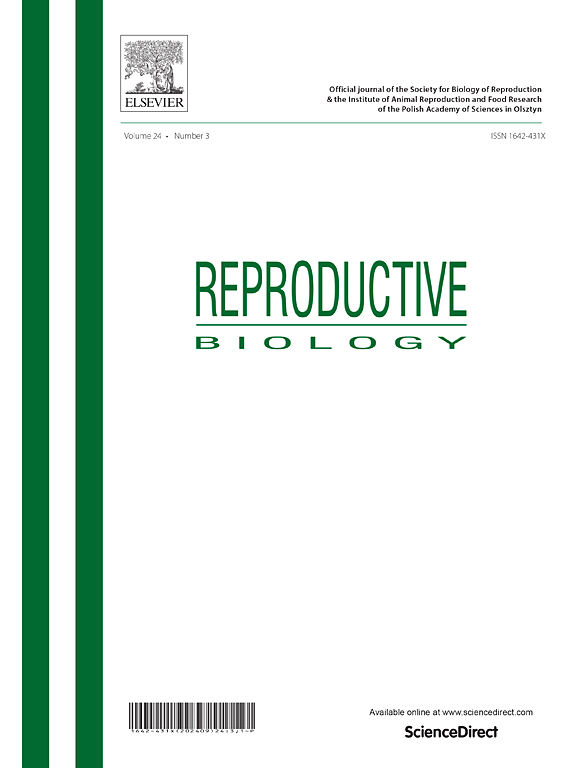Metformin-loaded Chitosan nanoparticles alleviate insulin resistance in the polycystic ovarian syndrome rat model through modulation of PI3K/AKT/ GLUT4 in ovarian tissue
IF 2.5
3区 生物学
Q3 REPRODUCTIVE BIOLOGY
引用次数: 0
Abstract
Polycystic ovary syndrome (PCOS) is a common disorder in females characterized by insulin resistance (IR), hyperandrogenemia and anovulation. The etiology of PCOS is unknown. However, disrupted phosphatidylinositol 3-kinase (PI3K) and protein kinase B/AKT signaling pathway may be a possible cause of IR in PCOS. Metformin can activate AKT via PI3K and improve IR. However, metformin alone has shown conflicting results. Chitosan nanoparticles (CSNPs) are natural nano-carriers with anti-diabetic effects. Therefore, we aimed to elucidate the therapeutic potential of metformin-loaded CSNPs (CSNPs-Met) in a letrozole-induced PCOS rat model. The study comprised five groups of rats: control, PCOS, PCOS plus metformin, PCOS plus CSNPs, and PCOS plus CSNPs-Met. Letrozole was found to successfully induce PCOS, as evidenced by elevated serum testosterone levels, homeostasis model assessment-insulin resistance (HOMA-IR), an increased number of cystic follicles, fewer corpora lutea and a disturbed estrus cycle. The pAKT and GLUT4 protein levels were significantly lower in ovarian and muscular tissues than in control group (P < 0.001), suggesting impaired insulin signaling and glucose transport that may contribute to both the metabolic and reproductive disturbances. CSNP-Met showed a significant decrease in testosterone, HOMA-IR, cystic follicles with an increase in the number of corpora lutea, as well as the levels of pAKT and GLUT4 in ovarian and muscular tissues (P < 0.001). In addition, the estrus cycle was restored to normal levels. Hence, CSNPs-Met showed superior efficacy in ameliorating PCOS-associated parameters relative to metformin alone. In addition, these results support future translational studies to explore the clinical applicability of CSNPs in PCOS management.
二甲双胍负载壳聚糖纳米颗粒通过调节卵巢组织PI3K/AKT/ GLUT4减轻多囊卵巢综合征大鼠模型的胰岛素抵抗
多囊卵巢综合征(PCOS)是一种以胰岛素抵抗(IR)、高雄激素血症和无排卵为特征的女性常见疾病。多囊卵巢综合征的病因尚不清楚。然而,磷脂酰肌醇3-激酶(PI3K)和蛋白激酶B/AKT信号通路的中断可能是PCOS中IR的可能原因。二甲双胍可通过PI3K激活AKT,改善IR。然而,单用二甲双胍产生了相互矛盾的结果。壳聚糖纳米颗粒(csnp)是具有抗糖尿病作用的天然纳米载体。因此,我们旨在阐明二甲双胍负载csnp (csnp - met)在来曲唑诱导的PCOS大鼠模型中的治疗潜力。研究分为五组大鼠:对照组、PCOS、PCOS +二甲双胍、PCOS + csnp、PCOS + csnp - met。来曲唑可成功诱导多囊卵巢综合征,表现为血清睾酮水平升高、稳态模型评估-胰岛素抵抗(HOMA-IR)、囊泡数量增加、黄体减少和发情周期紊乱。卵巢和肌肉组织中的pAKT和GLUT4蛋白水平明显低于对照组(P <; 0.001),表明胰岛素信号和葡萄糖转运受损可能导致代谢和生殖障碍。CSNP-Met显著降低睾酮、HOMA-IR、囊泡和黄体数量,以及卵巢和肌肉组织中pAKT和GLUT4的水平(P <; 0.001)。此外,发情周期恢复到正常水平。因此,csnp - met在改善pcos相关参数方面表现出优于单用二甲双胍的疗效。此外,这些结果支持未来的转化研究,以探索csnp在PCOS治疗中的临床适用性。
本文章由计算机程序翻译,如有差异,请以英文原文为准。
求助全文
约1分钟内获得全文
求助全文
来源期刊

Reproductive biology
生物-生殖生物学
CiteScore
3.90
自引率
0.00%
发文量
95
审稿时长
29 days
期刊介绍:
An official journal of the Society for Biology of Reproduction and the Institute of Animal Reproduction and Food Research of Polish Academy of Sciences in Olsztyn, Poland.
Reproductive Biology is an international, peer-reviewed journal covering all aspects of reproduction in vertebrates. The journal invites original research papers, short communications, review articles and commentaries dealing with reproductive physiology, endocrinology, immunology, molecular and cellular biology, receptor studies, animal breeding as well as andrology, embryology, infertility, assisted reproduction and contraception. Papers from both basic and clinical research will be considered.
 求助内容:
求助内容: 应助结果提醒方式:
应助结果提醒方式:


